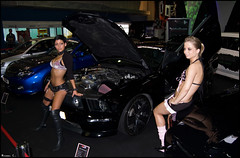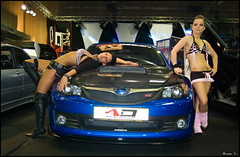New Powertrain line-up adds high efficiency and sovereign performance
Significant reduction in interior noise
Chassis improvements for better ride and handling
Updated design for a sporty-elegant look
The most notable changes in the Antara’s mid-cycle enhancements, which will be introduced at the end of this year, are in the powertrain. The fully re-worked engine line-up, all Euro-5 compliant, now offers improved driving performance as well as significantly reduced consumption and emissions. Even the two available transmissions – a six-gear manual and automatic – have undergone completely new developments to improve efficiency and dynamics.
The latest entry to the engine range is a newly-developed 2.2 CDTI Turbo diesel, which comes with two outputs. The 120 kW/163 hp offers 36 hp more than its predecessor model. The 135 kW/184 hp version offers 34 hp more power.
The 163 hp variant is available in front-wheel or all-wheel drive as well as with manual or automatic six-gear transmissions. The 184 hp also offers a choice of manual or automatic transmissions and comes with all-wheel drive as standard.
The gasoline line-up, too, offers more power. The 2.4 liter, four-cylinder version now comes with 125 kW/170 hp, or, 30 hp more power. Like the diesel variants, this engine is available in front-wheel or all-wheel drive and comes as manual or automatic six-gear transmission.
The engine variants come with variable camshaft phasing for the inlet and exhaust, which optimizes the torque and performance characteristics as well as lowers fuel consumption and emissions. Naturally an active, re-worked chassis fits nicely to the new Antara, offering dynamic handling and excellent traveling comfort.
Strong presence through accentuated front design
On the street, the Antara turns heads with its chic, upscale look. Its new, front grill with bold logo makes it immediately recognizable as a member of the new Opel design family. The fog lights together with chrome bezels and a well-blended pedestrian protection lends the vehicle a harmonious look with a strong presence. Modified rear lights and optional 19-inch light-metal wheels round out the robust look.
Designers have added a new Daydream Beige exterior color, to update the Antara’s palette. The new light beige creates a warm, upscale contemporary impression. This is in addition to the seven hues already on offer in Europe, allowing customers to find a color to meet their taste.
Inside, too, Opel has updated the choice to include a Light Titanium in the Cosmos trim level, in addition to the existing dark Saddle Brown and Jet Black. The lighter interior beautifully matches the new fabric and optimized instrument graphic and effective interior lighting. Together they underscore the prestigious ambiance of the cabin. A new center console with extra storage solutions has been added, thanks to the new electric parking brake, which opens up space between the two front seats.
Opel has improved safety and comfort features in the Antara as well. This includes a standard electric parking brake and a Hill Assist System. With these changes, the market segment of the compact SUV has a new competitor in the ring.
The dynamics of a passenger car with the talents of an off-roader
Chassis fine-tuning means the Antara is agile enough to maneuver its way through tough terrain, yet comfortable – and quiet – enough for daily drives to the city or soccer pitch. The enhancements ensure a high level of ride, handling, and safety performance. They include:
Improved stopping performance due to changes in the ABS efficiency, chassis tuning and 19-inch performance touring tires.
Application of Hill Start Assist on all vehicles, a feature that holds the vehicle on grades of three-percent or steeper for 1.5 seconds after the brake pedal is released. This technology essentially eliminates “roll-back” on hills when the vehicle needs to be stopped momentarily and ensures easier, confident “drive away” on grades;
New Electric Parking Brake Dynamic Assist (EPBDA), a feature in which the electronic brake control module applies four-corner braking in conditions where it is necessary to safely slow down the vehicle.
In addition, engineers have focused on a series of chassis hardware refinements to ensure enhanced vehicle dynamics like cornering, reduced “roll” characteristics, and improved ride feel.
The Antara’s four-wheel drive system combines the benefits of front-wheel drive − such as low fuel consumption and virtually effortless maneuvering − with those of four-wheel drive. While the engine normally powers the front wheels, the propulsion power can also be quickly and seamlessly distributed between the front and rear axle at a ratio of up to 50:50 when needed. The key element for this active function is an electronically controlled, electro-magnetically operated, electro-hydraulic differential on the rear axle. The compact and light four-wheel drive system is fully integrated in the ABS and ESP systems and supports the driver effectively in all driving situations, such as during heavy acceleration.
The new Opel Antara comes with three newly developed powertrains, upgraded manual and automatic transmissions, a re-tuned chassis and a new interior designed for more comfort.
With three newly developed powertrains, upgraded manual and automatic transmissions, a re-tuned chassis and a new interior designed for comfort, the Antara combines off-road capability with urban chic. Now, thanks to its attractive pricing, the next generation Opel Antara offers excellent value for money. The Antara 2.4 l (123 kW/167 hp) gasoline version with front-wheel drive starts at 26,780 euros in Germany.
This cool crossover meets the most exacting demands in terms of design, driving dynamics, economy and functionality. The enhancements are rounded off by a stylish exterior design and an interior which has been upgraded in terms functionality, look and feel. Together with the front and all-wheel drive options, the Antara offers something for everyone.
The powertrain range includes a newly developed common-rail diesel engine with 2.2-liters displacement and 2.4-liter gasoline engine. The 2.2-liter diesel is available in two output levels (120 kW/163 hp, 135 kW/184 hp). The gasoline version, which has also been upgraded, delivers 123 kW/167 hp. The 163 hp diesel and the gasoline-powered model are available with front or all-wheel drive and with manual or automatic six-speed transmission.
All engines meet Euro 5 emissions standards. Compared with their predecessors, they combine increased agility and driving dynamics with considerably lower fuel consumption and emissions.
Both transmission types are also available for the 184 hp diesel version, while the all-wheel drive system is standard with this engine. To match the new engines, the newly tuned chassis offers an extremely well-balanced combination of dynamic handling and suspension comfort.
The exterior highlights of the updated Antara include a newly designed front grille with the trademark Opel chrome bar, new fog lamps, adapted underride protection, modified rear lights and large-format, 19-inch alloy wheels. The enhanced interior features new paneling and upholstery materials, optimized instrument graphics, a new center console, additional storage space as well as elegant interior lighting. An especially high-grade leather version, called Light Titanium is available as an option.
“The new Antara combines the looks of a sporty off-roader with urban chic. It is practical, functional and equipped with state-of-the-art technology,” says Alain Visser, Vice President Marketing, Sales & Aftersales. “You really notice that it has undergone a major character change. With completely new engines and a newly tuned chassis, the car has become much more dynamic and more comfortable. In short: it offers clear added value in terms of driving pleasure.”

















.jpg)










